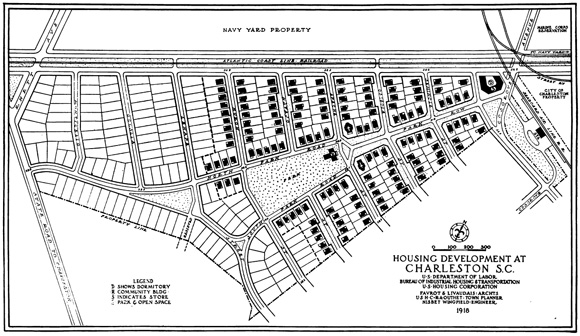Charleston, SC
General Description (1919 report):
"The city of Charleston, SC, located at the junction of the Ashley and Cooper Rivers, had a population of 59,000 in 1910, which had risen to about 100,000 in 1918, a great number being colored. At this time the rapid growth of population, including the soldiers stationed at Sullivan Island near Fort Moultrie, the marines and workmen at the navy yard, the soldiers and workmen at the embarkation camp, and their dependents, had utilized practically all the available housing and had outrun the development of the local railroad lines and trolleys...
"The city of Charleston offered to the Housing Corporation a tract of land adjacent to the navy yard - the best piece of land available...To meet the climatic conditions and the requirements of the people, a bungalow type of house was planned, the same as that decided on for the projects at New Orleans and at Pensacola. These were all detached houses, as there was a strong local prejudice against the semidetached type."

1919 excerpt describing the design of the Charleston site:
Area planned:30.74 acres. Housing planned: Detached houses, 136 families; apartment houses, 20 families; total, 155 families; 30 single workers in dormitories.
"The street system was planned as a simple meeting of the existing conditions. A main avenue leads from the community building on the park toward the apartment houses and railroad station, and so to the navy yard. The residential streets purposely do not invite through traffic, though they connect with existing streets. On some of them the houses are set back to form groups surrounding a litle quiet open space. An unusual feature of the plan is the cutting back of the lot corners along the main avenue, for greater amplitude and interest.
"In order to save as many of the existing trees as possible, shade being especially valuable, the gravel sidewalks were planned to be set practically on the existing surface in most places, any difference between sidewalk and road being taken up in the planting strips. The planting strips, too, were held as near the natural surface as possible, and the trees saved in them wherever this could be done. No formally arranged street trees were planned for, the scheme being to fill in the open spaces among the existing trees and produce ultimately the effect of houses standing in an open woodland."
The Charleston Site Today